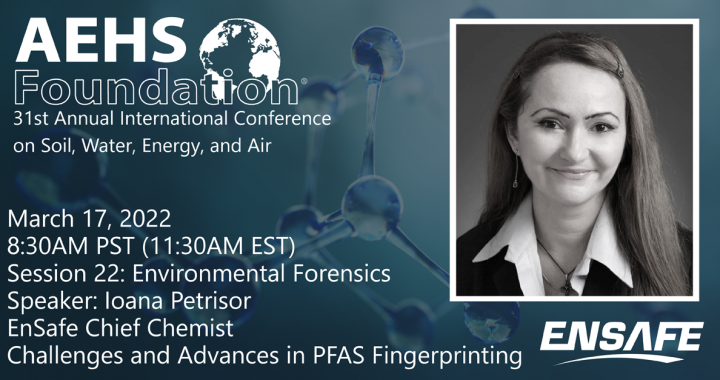EnSafe’s very own PFAS expert Dr. Ioana Petrisor will be speaking at the 2022 AEHS Conference on Soil, Water, Energy, and Air, which takes place virtually this year. Her talk, Challenges and Advances in Per- and Polyfluoroalkyl Substances (PFAS) Fingerprinting, is scheduled for March 17 at 8:30 AM Pacific time (11:30 AM EST), and will address the complexities of PFAS fingerprinting investigative techniques as scientists continue to learn and understand more about these “forever chemicals.”
Acknowledging the sheer abundance of PFAS, the myriad of potential PFAS sources, and the unique PFAS environmental behavior and transformations, Ioana’s lecture will delve into the key challenges of PFAS investigations, not only as it relates to sampling and analysis but also to the complications of data defensibility and interpretation because of PFAS transformative environmental behaviors.
Dr. Petrisor will focus on fingerprinting techniques like comprehensive chemical fingerprinting based on a larger number of individual compounds (including perfluoro -carboxylic and -sulfonic acids, fluorotelomer sulfonates, precursors, and replacement compounds); isomer profiles; fluorinated carbon chain characteristics; diagnostic ratios; total oxidizable precursors (TOP); and analysis of non-target compounds. She will discuss how these techniques can be evaluated and interpreted.
Scientists are only now truly beginning to understand the pervasiveness of PFAS and the tremendous impact PFAS has on the environment and human health. As the science continues to be further researched, it has become abundantly clear that PFAS toxicity is a major concern that will require additional EPA oversight and guidance.
Who is Dr. Ioana Petrisor?
A biochemist with 25 years of experience, Dr. Petrisor has been on the cutting edge of much of this early research. She has applied a variety of environmental forensic methods to track the source of and age-date environmental contaminants, including PFAS. She is actively involved with Interstate Technology and Regulatory Council (ITRC), being a member of the PFAS team, contributing to fate and transport and source evaluation sections of the developing technical guideline documents.
Her experience has proven that application of forensic techniques to PFAS not only facilitates differentiation of co-mingled plumes from onsite releases, but also can be used to distinguish between potential onsite release areas and many less publicized potential offsite or non-target sources, with substantial cost-saving implications. Her use of forensics tools is adapted to site specifics and may involve additional data collection using state-of-art fingerprinting techniques such as total oxidizable precursors and analysis of non-target PFAS compounds.
Dr. Petrisor has conducted innovative research for U.S. Department of Energy, U.S. Department of Defense , and the European Community on environmental characterization, risk assessment, and development of remedial technologies for soil, sediments, and water. She also boasts extensive publication experience and has taught numerous forensic courses.
We invite you to participate in this year’s 31st Annual International Conference on Soil, Water, Energy, and Air and sign up for Dr. Petrisor’s informative talk!
